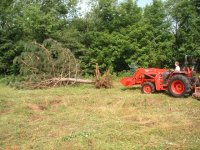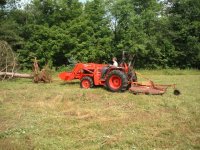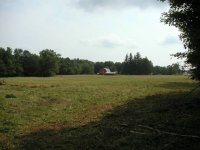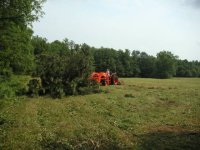You are using an out of date browser. It may not display this or other websites correctly.
You should upgrade or use an alternative browser.
You should upgrade or use an alternative browser.
Field clearing
- Thread starter cmsedore
- Start date
- Views: 2195
/ Field clearing
#1
Kodiak
Platinum Member
- Joined
- Apr 25, 2002
- Messages
- 859
- Location
- Monroe,Washington
- Tractor
- New holland TC29-9x3 Woods 1012 FEL, Woods, 7500 Backhoe / Kubota L345DT 4WD, Kub FEL, Kub Backhoe
Your son looks like he will grow up to be a very confident operator. I was around his age when I was introduced to our tractors, dozers and cranes.
patrickg
Veteran Member
cmsedore, I have the Kubota L4610HSTC and except for not enough cooling power in the A/C, I am mostly pleased. I too, have been dropping a few Juniper trees (locals call them cedar, but they aren't)
Let's compare notes on processes and results. I did about 50 trees in one morning. Largest were over 20 ft tall and about a foot or so in diameter. Smallest were just seedlings. I concentrate on the ones with berries as they are the females and the birds eat the berries, coat them in fertilizer, and plant them all over the pastures. I use the FEL to reach up and scrape branches on the side near me. I point the blade down and use it like a carving knife. This allows me to get close enough to push on the trunk without putting branches in the grill, radiator, or windshield. I reach up quite a ways and push with the FEL bucket which rears the fron wheels off the ground a few feet. If the tree goes over it is a soft landing due to the branches on the other side. If it doesn't then I back up and check the near side roots to see if any broke the surface. If yes then I dig at them a bit to weaken them and push on the tree again, usually lower down. If I push too hard and too high it breaks the trunk and leaves a stump or if I don't loosen the near side roots enough. Pushing too low is a waste of time. Root systems seem really shallow on this species.
Might save some trunks for posts as "cedars" have been used historically for posts with good results. I will run the rest through the chipper and burn anything that is ill behaved or in excess to my chip requirements (not too likely).
I have it on good authority (extension agent) that if you cut one down below its lowest limb it is dead. If the weather were cooler and I wasn't looking for tractor jobs, whacking them at ground level with a chainsaw would probably be easier, if yoiu aren't going to plow the area.
What is your approach and how well does it work?
Patrick
Let's compare notes on processes and results. I did about 50 trees in one morning. Largest were over 20 ft tall and about a foot or so in diameter. Smallest were just seedlings. I concentrate on the ones with berries as they are the females and the birds eat the berries, coat them in fertilizer, and plant them all over the pastures. I use the FEL to reach up and scrape branches on the side near me. I point the blade down and use it like a carving knife. This allows me to get close enough to push on the trunk without putting branches in the grill, radiator, or windshield. I reach up quite a ways and push with the FEL bucket which rears the fron wheels off the ground a few feet. If the tree goes over it is a soft landing due to the branches on the other side. If it doesn't then I back up and check the near side roots to see if any broke the surface. If yes then I dig at them a bit to weaken them and push on the tree again, usually lower down. If I push too hard and too high it breaks the trunk and leaves a stump or if I don't loosen the near side roots enough. Pushing too low is a waste of time. Root systems seem really shallow on this species.
Might save some trunks for posts as "cedars" have been used historically for posts with good results. I will run the rest through the chipper and burn anything that is ill behaved or in excess to my chip requirements (not too likely).
I have it on good authority (extension agent) that if you cut one down below its lowest limb it is dead. If the weather were cooler and I wasn't looking for tractor jobs, whacking them at ground level with a chainsaw would probably be easier, if yoiu aren't going to plow the area.
What is your approach and how well does it work?
Patrick
Egon
Epic Contributor
Patrick:
I do about the same for removing trees. Only difference my tractor is much smaller. To remove branches I use the side of the bucket and lift. For digging roots I have to first push on the tree from all sides and watch for any movement of dirt. That is where I start digging to cut of roots. I first dig straight into the tree to get a little angle and then go at 90 degrees to rhe root using the corner of the bucket to cut the roots. If on a hill I always push downhill for obvious reasons. Evergrees are much easier to remove than oak or maple which have a tap root the bucket can't reach. From the looks of the root on the tree in the posted picture I beleive the little 7100 could have done it but it takes more time.
Egon
I do about the same for removing trees. Only difference my tractor is much smaller. To remove branches I use the side of the bucket and lift. For digging roots I have to first push on the tree from all sides and watch for any movement of dirt. That is where I start digging to cut of roots. I first dig straight into the tree to get a little angle and then go at 90 degrees to rhe root using the corner of the bucket to cut the roots. If on a hill I always push downhill for obvious reasons. Evergrees are much easier to remove than oak or maple which have a tap root the bucket can't reach. From the looks of the root on the tree in the posted picture I beleive the little 7100 could have done it but it takes more time.
Egon
Thanks for saying so. My sons are 9 and 7 and anxious to get bigger. I started driving equipment at about 12 and will probably start them at that time. I do let them steer for short rides on the lawn occassionally (a safe, predictable area, of course).
My daughter is 5 and she's not as interested yet, but I think she will get into it as she's older. I'm happy to have her as daddy's girl for now /w3tcompact/icons/smile.gif.
-Chris
My daughter is 5 and she's not as interested yet, but I think she will get into it as she's older. I'm happy to have her as daddy's girl for now /w3tcompact/icons/smile.gif.
-Chris
Patrick,
It sounds like we do it the same way. The only thing I'd add is that if I can't move it after pushing it over, I'll often swing around perpendicular to the trunk and give it another push. Often by doing this and rolling the bucket back, I can pop it out of the ground. I agree about pushing them too low--anything lower than about 4-5 feet is not productive (except on really small trees).
I like pushing them over where possible because it doesn't leave stumps behind. The stumps seem to hang around forever, as bumps in the field and obstacles for implements to hit/ride over. (I hate getting too close to the ground with the chainsaw--then I spend too much time sharpening...)
This tree was probably the largest diameter I've tried, but I've done a number of smaller cherry and such in another field I'm cleaning up. A couple maple and some thorn apple as well.
I'm still trying to decide what to do with the trees. I'm planning to build a grapple for my bucket (or possibly forks with a grapple) to move them around. I don't have a chipper, but do have plenty of space where I could just let them rot out of the way. I may end up doing just that. Some I may cut up and burn in my outdoor furnace.
-Chris
It sounds like we do it the same way. The only thing I'd add is that if I can't move it after pushing it over, I'll often swing around perpendicular to the trunk and give it another push. Often by doing this and rolling the bucket back, I can pop it out of the ground. I agree about pushing them too low--anything lower than about 4-5 feet is not productive (except on really small trees).
I like pushing them over where possible because it doesn't leave stumps behind. The stumps seem to hang around forever, as bumps in the field and obstacles for implements to hit/ride over. (I hate getting too close to the ground with the chainsaw--then I spend too much time sharpening...)
This tree was probably the largest diameter I've tried, but I've done a number of smaller cherry and such in another field I'm cleaning up. A couple maple and some thorn apple as well.
I'm still trying to decide what to do with the trees. I'm planning to build a grapple for my bucket (or possibly forks with a grapple) to move them around. I don't have a chipper, but do have plenty of space where I could just let them rot out of the way. I may end up doing just that. Some I may cut up and burn in my outdoor furnace.
-Chris
ScottAR
Veteran Member
Not sure I would pile them around. This creates a fire hazard. I never thought much about it either till some wayward crackheads started a pile on our property. The fire killed about 3 trees and burnt over an acre before the fire department arrived. Also burnt the tires off a disk we had stored nearby.




